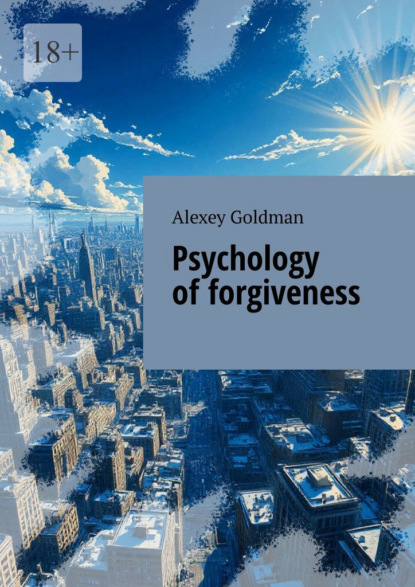- -
- 100%
- +

© Alexey Goldman, 2025
ISBN 978-5-0068-0155-4
Created with Ridero smart publishing system
Alexey Goldman
Psychology of forgiveness
Chapter 1: Why Resentment Is Not About Them, But About You
Imagine this: you’re walking down the street, carrying a heavy stone in your hands. Passersby ask you, «Why are you carrying that?» You reply, «Because that person threw it at my back!» But here’s the thing: you are the one carrying it now. The person who hurt you has probably long forgotten they ever threw it.
This chapter is about how to set down that stone. Not for the sake of the person who threw it. For your own sake. Because resentment is less about another person’s action and more about how you continue to live with that pain.
What happens when we hold onto resentment?
Resentment is like a wound we keep irritating, day after day. Even if the person who caused the pain has long left our lives, we mentally return to that moment again and again:
We retell the story to friends, each time only amplifying the pain.
We replay the details in quiet moments – at night, in traffic, at work.
We construct imaginary dialogues in our heads: «I should have said this…", «And he would have answered that…».
But the most important thing is this: as long as you hold onto resentment, you are paying for it with your inner peace. The offender has most likely moved on with their life. But you haven’t.
A real-life example:
Marina didn’t speak to her brother for five years. The reason: he didn’t come to her wedding, claiming he was too busy. Later, it turned out he was going through a difficult divorce at the time and was afraid of appearing weak. But Marina was angry for years: «How could he? I’m his sister!» She told this story to everyone, she cried, and eventually, she received his apology. And her brother? He moved to another city, started a new family, and hardly ever remembered that conflict.
The takeaway: Marina thought her behavior was punishing her brother. But she was only punishing herself.
Why do we cling to resentment?
We think resentment is a form of protection. We’re afraid that if we «forgive,» we will:
Become vulnerable.
Admit that what happened was insignificant.
Allow others to hurt us again.
But in reality, resentment is an attempt to control the past. We think: «If I stay angry, it will somehow fix the situation.» But the past cannot be changed. You can only decide how to live with it now.
Why is this harmful?
By holding onto resentment, we:
Strain our bodies. Muscles tense, the stomach clenches, a lump forms in the throat. This is the «fight or flight» response – the body is preparing for a conflict that is already over.
Reinforce negative neural pathways. The more often we recall the hurt, the more deeply it gets «hardwired» into the brain. At first, we remember it once a week, then every day, then at the slightest hint of a similar situation.
Waste energy. Instead of solving current tasks, the brain spends its resources endlessly rehashing the past.
Example:
Sergei couldn’t forgive his ex-girlfriend for leaving him. Every time he saw a couple in a cafe, he remembered their last conversation. Because of this, he couldn’t concentrate at work and started missing meetings. A year later, he realized: his ex had already gotten married, while he had lost out on a promotion.
Exercise: «Who Is Carrying the Burden?»
Try doing this right now. Take a piece of paper and answer these questions:
Describe the situation.
«My colleague Irina took credit for my project and presented it at a meeting as her own. I stayed quiet to avoid conflict.»
How does this affect you NOW?
«Every time Irina talks about the meeting, I clench my fists until they hurt. I can’t concentrate. At home, I snap at my husband over little things – because I can’t express my anger to her.»
What does the offender think?
«Irina probably doesn’t even remember it. She got a bonus and is happy.»
Who is paying the price?
«I am. My nervous system, my relationship with my husband, my career.»
This exercise works because it shifts the focus from «he is guilty» to «I am suffering.» When you see that you are the one suffering, the motivation to let go of the resentment becomes stronger.
Technique: «The Hot Coal»
Imagine your resentment is a red-hot coal in the palm of your hand.
You hold it, thinking: «This will punish him.»
But who is getting burned? You.
If you drop it – the pain will stop. But at first, it’s scary: «What if I regret it?»
How to use it:
In a moment of anger, ask yourself: «Am I holding this coal for myself or for him?»
If the answer is «for him» – add: «But he doesn’t even know I’m holding it.»
Let go gradually:
By 5%: «Today, I won’t talk about this with anyone.»
By 20%: «I will stop checking his social media profiles.»
By 50%: «I will be able to wish him a good morning at work.»
Example:
Lena harbored resentment towards her mother for years for a lack of support during her divorce. Every conversation ended in tears. She tried the «hot coal» technique:
First, she stopped calling her mother on weekends (5%).
Then, she deleted old text messages (20%).
At 50%, during a meeting, she simply said: «Thank you for coming.» Her mother was surprised, but Lena felt the tension in her chest release.
Why this works:
The brain doesn’t like sudden changes. Gradually loosening your grip allows anxiety levels to decrease. You’re not saying «I forgive,» you’re simply holding on less tightly. And that is already a step towards freedom.
What to do if «I’ve already let go»?
We often think: «I’ve forgotten that story.» But then we hear the offender’s name – and the anger returns. This doesn’t mean you haven’t let go. It means the resentment is still living in your body.
How to check:
Recall the situation.
Close your eyes and ask: «Where in my body do I feel this right now?»
Head? (headache, pressure)
Chest? (tightness, shortness of breath)
Stomach? (heaviness, a knot)
Say out loud: «This tension is not about now, it’s about then.»
Example:
Andrei thought he had «long forgiven» his friend for a betrayal. But when he saw him at a mutual friend’s wedding, he felt a stabbing pain in his temple. He realized: the resentment was sitting in his body. He did this:
Stepped aside and placed his hand on his temple.
Said: «I feel pain here. This is a memory, not reality.»
Took 5 deep breaths. The headache was gone within 10 minutes.
The science, simplified:
When we experience stress, the body remembers the reaction. The next time a trigger appears (a name, a place, a smell), it repeats it automatically. But if, at the moment of reaction, you consciously say, «This is not now,» the connection between the trigger and the pain weakens.
Why forgiveness is a gift to yourself
We often think: «If I forgive, he wins.» But imagine this:
You are in a cell, holding the key to the door. Your offender is outside.
You scream: «Give me the key!»
But he has long gone on vacation and forgotten you exist.
Who is suffering? Only you.
Forgiveness is not «I’m letting him win.» It’s «I am taking the key and unlocking the door.» You are not changing the past. You are choosing whether to live in the cell or walk free.
A story to ponder:
Olga hadn’t spoken to her father since she was 12. He left the family when she was 10. She hated him, convinced he was suffering from loneliness. When she accidentally learned of his death, her first thought was: «Now I will never get an answer.» She went to the funeral, stood by the coffin, and suddenly understood:
He had not suffered. He had created a new family and was happy.
And she had lived as his prisoner for 12 years.
She didn’t «forgive» him. But she said: «I release you. Not for you. For me.» And for the first time in many years, she was able to sleep soundly.
Practical steps for this week:
Find your «stone.»
Write down one resentment that still evokes a response. Simply describe: «When I remember [situation], I feel [emotion].»
Check whose burden it is.
Ask yourself: «If I let this go, what will change for him? Nothing. What will change for me?»
Take a 5% step towards letting go.
For example:
Don’t retell this story for the next 3 days.
Put a photo or object associated with that situation away in a distant drawer.
Tell yourself: «That was then. Now I choose to breathe easily.»
Forgiveness is not erasing memory. It is a decision:
To no longer allow the past to control your present.
To stop paying for others’ mistakes with your own peace of mind.
You are not weak if you let go. You are wise. Because you understand: the main person you can change is yourself.
Try today to look at your resentment as a stone in your palm. Don’t throw it down sharply – just unclench your fingers. And let it fall. You deserve to move on. With empty, but free hands.
Chapter 2: Forgiveness Is Not Weakness, Nor Is It Approval
«I can’t forgive. That would mean I condone what he did!» – that’s what many people think. But forgiveness is not about dividing the world into «black» and «white.» It’s about stopping being a hostage to someone else’s mistake. In this chapter, you will understand: to forgive is not to be weak. It is to become free.
What forgiveness is NOT
Before we talk about forgiveness, it’s important to understand what it is not:
Justifying the action. «He hit me because he was drunk» – that’s not forgiveness, that’s making excuses.
Reconciliation. You can forgive a person and still stop communicating with them.
Forgetting. The memory may remain, but it stops causing pain.
Demanding an apology. Your inner balance should not depend on another person’s words.
Example:
Katya forgave her ex-boyfriend for cheating, but she did not take him back. She said: «I am not justifying what he did. But I am tired of being angry. I choose myself.»
Why we are afraid to forgive
The fear of forgiveness is the fear of losing control. We think that:
If we forgive, we will look foolish.
The offender will think they can get away with anything.
We will «betray» our pain, as if it wasn’t important.
But in reality, by not forgiving, we give the offender power over our lives. As long as you hold onto anger, you allow them to influence your emotions, your decisions, and your health.
How it works:
Imagine you’re driving a car, and the person who hurt you is sitting in the back seat. They’re yelling: «You’re an idiot!», «Turn back!»
If you turn around and argue with them – you won’t see the road.
If you cover your ears – they will keep yelling.
Forgiveness is asking them to get out of the car. You are not erasing the memory of the trip. But you are no longer allowing them to interfere with your journey forward.
Exercise: «I Forgive Not Because You Deserve It»
Take a piece of paper and write:
«I forgive not because [name] deserved it. I forgive because:
I am tired of carrying this pain.
I want to sleep peacefully.
I deserve to be happy, even if he/she doesn’t understand that.»
Why do this?
When we tie forgiveness to the principle of «deserved/didn’t deserve,» we hand the offender the key to our emotions. This exercise gradually returns control to you: you are forgiving for your own sake, not for theirs.
Example:
Pavel couldn’t forgive his father for years for leaving the family. He wrote in his journal: «I forgive not because you deserved it. I forgive because:
I am tired of waking up with thoughts of you.
I want to be a good father to my own son.
I deserve to live, not to hate.»
A month later, he stopped seeing his father in his dreams.
When «to forgive» does NOT mean «to stay»
Many people confuse forgiveness with resuming a relationship. But you can forgive and set healthy boundaries.
How to do it:
Acknowledge: «His action was unacceptable.»
Tell yourself: «I release the pain, but I will not allow the mistake to be repeated.»
Act:
Reduce communication.
Set clear rules: «If you speak to me in that tone, I will end the conversation.»
Don’t justify your decision – you don’t owe anyone an explanation.
Example:
Natasha forgave her friend for gossiping but stopped sharing personal details with her. She said: «I’m glad we’re not enemies anymore. But I won’t discuss my relationships with you.» The friend was offended at first but eventually accepted these boundaries. Natasha, meanwhile, felt like she could «breathe more freely.»
Why forgiveness is strength, not weakness
Weakness is living as a prisoner of the past. Strength is consciously letting go of what holds you back.
The science, simplified:
When we hold onto resentment, the brain activates the area responsible for physical pain (the anterior cingulate cortex). This means the brain processes emotional and physical pain in the same way. By forgiving, we «turn off» this area – and both body and mind begin to heal.
An inspiring story:
During the war in Bosnia, a woman named Sabina lost her son in a bombing. Twenty years later, she met a man who had participated in that raid. Instead of hatred, she asked him: «Did you lose anyone in that war, too?» He answered that his brother had died on the other side. Sabina said: «I do not justify what happened. But I don’t want to carry evil within me. Let’s wish each other peace.» It didn’t erase the pain of loss. But it freed her from the burden of revenge.
Technique: «The Action vs. My Future»
Divide a sheet of paper into two columns:
His Action (The Past) My Future (What I Have a Right To)
He betrayed me. I can build trust with new people.
She humiliated me in public. I can stand up for my boundaries.
They didn’t support me. I can surround myself with people who value me.
How to use it:
Write down your conflict in the two columns.
Focus on the right side.
Add specific steps:
«I will meet three new people this month.»
«I will say ’stop’ if I feel disrespected.»
Example:
Maria filled out the table after a conflict with her boss:
Action: «She unfairly deprived me of a bonus.»
Future: «I will get a job at another company that values honesty.»
Action: «She publicly humiliated me.»
Future: «I will learn to respond calmly to criticism.»
Two months later, she quit – but without malice. «I don’t feel hatred for her,» says Maria. «I am grateful for that lesson, as it made me stronger.»
What to do if «I don’t want to forgive»
That’s okay. Forgiveness is a process. If you’re not ready, tell yourself:
«I do not forgive. But I am willing to try not to think about it every day.»
«I do not forgive. But I will stop retelling this story.»
Practice:
Write a letter to the offender (write everything you feel).
Burn it or hide it far away.
Say out loud: «These are my emotions. I give them to the fire/to time. I choose myself.»
Why this works:
Writing allows you to vent emotions without the risk of conflict. Burning symbolizes completion. This isn’t full «forgiveness» yet, but it’s an important step towards liberation.
Story:
Andrei wrote his father 10 pages of anger. He burned them. Then he took a bath and cried out all the pain. The next day, he didn’t become a «perfect son,» but he stopped drunk-dialing his father with accusations. «I haven’t forgiven him,» he says. «But I no longer want to be like him.»
How not to confuse forgiveness with enabling
Important: forgiveness does not mean you have to tolerate bad treatment.
The Rule of Three D’s:
Distance. If a person harms you – distance yourself or walk away.
Dialogue. If you’re ready – say: «This is not okay with me. Let’s discuss it.»
Action. If dialogue is impossible – protect yourself (limit contact, leave).
Example:
Olga forgave her husband for cheating but did not return to him. She said: «I don’t want to be with a person who treated me like that. But I don’t want to live in hatred.» Now she lives alone, but with a sense of peace. «Forgiveness freed me from his shadow,» she says.
Practical steps for this week:
Write your manifesto.
Write: «I forgive not for [name]’s sake, but for [your reason].» Finish the phrase, focusing on yourself.
Do the «separation.»
Fill out the «Action vs. My Future» table.
Try 1% forgiveness.
For example:
Tomorrow morning, don’t think about the offender.
Instead of «how could he?» say «I choose to breathe easily.»
Forgiveness is not a heroic feat. It is a quiet, personal choice:
To no longer be a hostage.
To stop paying for others’ mistakes with your present.
You are not weak if you let go. You are wise. Because you have understood: the main person you can change is yourself.
Try today to look at your resentment as a stone in your palm. Don’t throw it down sharply – just unclench your fingers. And let it fall. You deserve to move on. With empty, but free hands.
Chapter 3: How Resentment Lives in the Body and Mind
Resentment isn’t just a thought or an emotion. It’s a deep, physical experience. When we hold onto anger, it «settles» into our muscles, joints, and constricts our breathing. And if we don’t release it, the body starts to «speak» for us: with headaches, insomnia, chronic fatigue. In this chapter, you will learn to recognize the traces of resentment in your body and reclaim your peace – without complex terms, just practical guidance.
How resentment gets «stuck» in the body
Imagine: you’re walking through the woods and step on a sharp thorn. It hurts! You stop, pull it out – and the wound heals. But if the thorn remains inside – the wound will fester, your leg will ache, and you’ll start to limp.
Resentment is that very thorn we failed to pull out.
At first, the pain is sharp: «How could he do that?!»
Then we get used to it: «Okay, I’ll just forget about it.»
But the thorn remains. And with every step (a new situation, a similar person, a familiar smell), the pain reminds us it’s still there.
Example:
Elena went through her husband’s infidelity. A year later, she had «sort of forgotten,» but every night she would wake up three hours after falling asleep with a lump in her throat. Doctors found no cause. Later, she pieced it together and realized: it was at exactly 3 a.m. that he had cheated on her. Her body remembered what her mind was trying to forget.
Where does resentment live? A map of your body
Every experience has its own «address» in the body. Here are typical areas where resentment takes up residence:
Emotion Area in the Body Sensation
Resentment Chest, throat, neck Tightness, lump, shortness of breath
Anger Jaw, fists Tension, trembling, clenched teeth
Shame Stomach, shoulders Heaviness, slumped shoulders
How to check:
Recall a situation that still brings up pain.
Close your eyes and ask yourself: «Where in my body do I feel this right now?»
Place your palm on that spot. What do you feel?
Burning?
Cold?
Tension?
Pulsation?
Example:
Anton was angry at a friend for betraying him. Remembering it, he felt his jaw clench involuntarily. He put his hand on his cheek and suddenly remembered: as a child, when his father yelled at him, he would clench his teeth the same way. The resentment had been hiding in his body since those long-ago days.
Why the body remembers more than the mind
The brain may forget the details, but the body stores the memory of stress.
How it works:
A traumatic situation occurs (yelling, betrayal, infidelity).
The body activates «fight or flight» mode:
Muscles tense up.
Heart rate increases.
Breathing becomes shallow or stops.
If the emotion isn’t expressed (you don’t cry, scream, or react), the muscle tension remains.
Years later, when a trigger appears (a voice, an intonation, a situation), the body automatically repeats the same reaction. You haven’t «remembered» the resentment – your body itself launched a defense program.
Example:
Marina hadn’t spoken to her sister for 10 years. During a chance encounter, she suddenly felt her hands trembling. Later, she realized: as a child, when her mother shouted, Marina would hide under the table and clench her fists. Her body remembered that reaction and reproduced it.
Exercise: «Body Scan»
Do this every time you feel tension:
Sit comfortably, close your eyes.
Ask yourself: «Where am I holding this resentment?»
Mentally scan your body:
Legs: feel heavy, numb?
Stomach: a knot, tension?
Chest: tightness, pain?
Neck: stiffness?
Face: lips pursed, forehead tense?
Place your palm on the area of tension. Say: «This is not now. This is a memory.»
Breathe into that area:
On the inhale: «I feel you.»
On the exhale: «I release you.»
Why this works:
When we focus on bodily sensations, the brain switches from the «story in the head» to the present moment. The touch of a hand sends a signal of safety. Deep breathing lowers stress levels.
Example:
Dmitry suffered from insomnia for years after a betrayal. He did a «body scan» and discovered the tension was concentrated in his shoulders. Every evening, he would lie on the floor, placing a small cushion under his shoulder blades, and breathe, directing his attention to that area. Within a week, he was sleeping without sleeping pills.
How breathing «erases» resentment
Breathing is a simple yet powerful tool. When we are angry, our breathing becomes rapid and shallow. Conscious breathing returns control and calms the nervous system.
The «4-7-8» technique for working with resentment:
Inhale through your nose for a count of 4.
Hold your breath for a count of 7.
Slowly exhale through your mouth for a count of 8 (with a slight whooshing sound, as if blowing out a candle).
Repeat the cycle 3—4 times.
When to use it:
Before bed, if a conflict is «spinning» in your head.
After a conversation that caused anger.
In the morning, to start the day without the burden of the past.
Example:
Olga used this method after an argument with her son. Instead of dwelling on the hurt, she did the «4-7-8» and told herself: «This isn’t about me. This is about his stress.» A month later, her son noticed her calmness and started being the first to reconcile.
Why we ignore bodily signals
We often blame bodily symptoms on fatigue: «I’m just overworked,» «I’ve always had headaches.» But the body doesn’t lie. It’s saying: «You’re still angry.»
Typical «masks» of resentment:
Insomnia. It seems you can’t sleep because of «thoughts,» but it’s actually because of tense muscles.
Headaches. Pain in the temples or the back of the head is often a sign of a clenched jaw or neck tension.
Chronic fatigue. The body spends huge resources maintaining chronic tension.
Digestive issues. Stress «settles» in the stomach («knot,» nausea, constipation).
How to check:
Write down: «When my [body part] hurts, I remember [situation].»
For example: «When my neck hurts, I remember my boss yelling at me.»
If you find more than 3 such coincidences – resentment is firmly rooted in your body.
Technique: «Mirror of Emotions»
Sometimes we don’t notice how resentment distorts our face and posture. This exercise helps you see the connection.
Stand in front of a mirror.
Recall a situation that still hurts.
Say out loud: «I am angry because… [reason].» For example: «I am angry because you didn’t support me.»
Look carefully at your reflection:
Which muscles tensed up?
How did your breathing change?
What happened to your facial expression?






